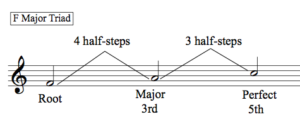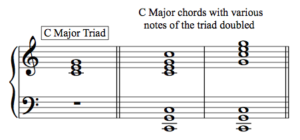Playing music without understanding how major triads work is like building Ferraris without caring what's under the hood - you're missing an opportunity to understand one of the most important building blocks of ALL of Western music...major triads!
Thankfully, you've discovered this blog post so that you can now fully comprehend the intrinsic POWER of this little 3-note major triad and wield its limitless potential with ALMIGHTY FURY AND DOMINION!!! Ok, ok. I may have gotten a little carried away there. The major triad is not a way to exert your plan for world domination...(yet). But if you don't already understand how it's constructed, how often it appears in music, and how many different applications it can have, you are in for a treat. Allow me to explain.
The major triad is constructed by using 3 notes: the root, major 3rd, and perfect 5th of any key. If you don't fully understand intervals, no problem. You can build a major triad by starting on any note (called the "root") and counting up 4 half-steps (which brings you to the major 3rd) and then counting up another 3 half-steps (which brings you to the perfect 5th). Play these three notes together and you've just played a major triad. You can now apply this formula starting on every key, and doing so will result in all 12 major triads.

But wait - there's more! Not only can you play these major triads in "root position" (i.e., when the note for which the chord is named is the lowest note in the chord), but you can also mix up the order of these notes and create two inversions.

But hold on! There's even more power behind these major triads! Don't think you have to ONLY play them in 3-note groupings. You can double any of the notes of the major triad to create various sonic textures, resulting in more robust and thicker-sounding chords.

Now let's look at just a few of the many applications in which this powerful little chord can be found.
If we break the major triad up into two parts, playing first the root and then the upper two notes (3rd and 5th simultaneously) we get a waltz accompaniment when played in 3/4 time. Johann Strauss knew this when he used this mighty little chord to compose his famous piece Blue Danube Waltz.

Mozart used the major triad with great success when he wrote his popular little ditty "Piano Sonata No. 16 in C Major, K. 545." He utilized what is known as an "Alberti bass" accompaniment, which simply takes the three notes of the triad and breaks them up into an alternating pattern (lowest note of the chord, highest note, middle note, highest note). Notice in the first measure that the left hand Alberti bass accompaniment uses a simple C major triad, and the melody (right hand) is simply a C major triad with the notes played one at a time.

Maybe one of the most famous classical melodies of all time (certainly the case at weddings), Canon in D by Johann Pachelbel is a piece of ear-candy based entirely on major and minor triads, varying between root position and inversions. Aside from building an entire piece of music on only 4 measures of repetitive harmony, Pacehelbel also gave us a chord progression which has been copied over and over and over... and over again by musicians in all genres of music.

Major triads (and minor triads) are the first step to understanding harmony and chords, which is essential understanding if you want to learn how to improvise, how to read a fakebook or leadsheet, how to transpose, how to use chord scales, or how to compose your own music. For more information on major triads and other music theory topics check out our Music Theory Crash Course, where I talk about these topics extensively and offer quizzes, worksheets, answer sheets, and a corresponding text.
Excellent Willie! I used to be so afraid of reading music but you have made it so plain that all these broken up notes are simply just triads or an added extention. Thanks so much. It takes the frustration out of sight reading.
Willie , I was looking for your lesson on minor triad and seventh chord constructions for Natural minor, and the different choices you made for most-used triads and seventh chords in the natural minor scale....for example the ii_7 not being a diminished chord. Can't find the lesson.....
Truly you have a gift for explaining all of this and generating enthusiasm for ongoing study! The information really sticks when the method for forming ( or recognizing) the triad and such well known examples are put together in the same concise article. Thanks for this clarification of what to look for.